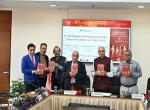India’s economic growth is accelerating at a steady pace with a glimpse of its true potential to become the world’s fastest-growing economy soon. In 2019, India ranked as the second-largest online market, after China. According to data by Statista, in 2020, India had 700 million internet subscribers across the nation; as a projection, these numbers will grow to over 974 million internet users by 2025. In the continuation to the monthly discourse on contemporary issues, the Vivekananda International Foundation (VIF), on 23 November 2020, organised a virtual Vimarsha on “India’s Digital Leap” in which Shri Ram Sewak Sharma, former Chairman of the Telecom Regulatory Authority of India (TRAI), was the guest speaker.
In his introductory remarks and welcoming Shri Ram Sewak Sharma, Dr Arvind Gupta (Director, VIF)highlighted how the digital leap plays an essential role in transforming India in every domain. In 2015, the Government of India (GoI) launched the “Digital India” programme. Since its inception, successful projects under “Digital India” build digital infrastructure and applications in various areas. Referring to Aadhaar—unique identification number, among other national digital programmes, Dr Gupta emphasised Aadhaar’s contribution to the digital revolution as being the bedrock of the digital India leap. Amid the coronavirus pandemic, digital India played a crucial role in transforming the education sector, health sector, and other social sectors. A progressive India's projection is unimaginable without the digital revolution in various forms, such as advanced internet technology (IoT), smart phones, and other applications & services.
The Digital India Programme
While narrating the Digital India programme's journey, Shri R S Sharma referred to an anecdote—an interaction between the Hon’ble Prime Minister of India—Shri Narendra Modi and Shri Sharma & his team members. Shri Sharma recalled PM Modi’s broader vision of the digital India programme—a “programme which must [transform] India into a digitally empowered society and a knowledge economy.” For the crafted digital India programme, three essential components required— i) the digital infrastructure as a utility to citizens, ii) software and services, and iii) citizens’ empowerment. The third element was the most crucial component of the digital India programme because the software, services and digital infrastructure would have been useless if citizens could not utilise these three components. In 2015, the JAM trinity (Janadhan, Aadhaar, and Mobile) became the empowering trinity of service delivery with a vision to empower citizens. With the help of a PowerPoint presentation, Shri R S Sharma presented the “India’s Digital Leap” by categorising it into three sections— i) India’s Digital Leapfrog, ii) Challenges of a Big Tech Era, and iii) The Way Forward.
India’s Digital Leapfrog
Shri R S Sharma highlighted that in 2008, only 17 per cent of India’s population had bank accounts, and out of these 17 per cent people, only 15 per cent used digital payments; one in 25 people possessed a Unique Identification (UID) document, mainly Passport travel document. The financial exclusion was rampant because the majority of the rural population had unavailability of UID documents. Despite the document's availability, the deposit amount was much smaller in proportion to the cost of acquisition of customers’ paperwork, etcetera, by the banks. Highlighting India’s digital journey from 2008 to 2020, Shri R S Sharma informed the participants that India embraced the digital revolution with 1.2 billion mobile connections, 1.22 billion people successfully enrolled on the Aadhaar UID programme, which means 1.22 billion digital identities. Compared to the minimal number of internet users in 2008, India has 636 million internet subscribers by 2020. Highlighting the UPI interface's success, Shri R S Sharma informed that in a single month, i.e. October 2020, around two billion digital transactions took place through the UPI payment interface.
Public Digital Infrastructure
Shri R S Sharma credited the “India Stack”—a set of Public Digital Infrastructure (PDI) for India’s digital platform progress. The PDI included both hardware and software components. The PDI consist of three layers— i) Identity Layer (gives access to any formal institution via Aadhaar, eKYC, eSign), ii) Payments Layer (enable anyone to pay anyone else via IMPS, UPI, BBPS), and iii) Data Empowerment (to allow secure data access and sharing via Digi Locker, digital Consent Artefact). In the absence of any verifiable UID document, an individual cannot access any formal or official system. Furthermore, the lack of verifiable UID results in duplication in government services and subsidies. Aadhaar was India’s first digital UID platformto be used in any domain, such as opening a bank account. As the world’s most extensive biometric identification, Aadhaar enrolled 99 per cent of the adult population across India, with enrolment counts of 2 million/day at its peak. Based on the guiding principles of cost-effectiveness and digitally robust, Aadhaar’s API (Application Programming Interface) for authentication and eKYC enabled presence-less and paperless verification to access various services.
Holy Trinity: Jan Dhan-Aadhaar-Mobile (JAM)
According to TRAI’s data, over 1.2 billion mobile connections connect over 700 million unique mobile subscribers. Aadhaar and eKYC enable smooth SIM registrations of the citizens of this nation. As essential components of the payment layer—Aadhaar enabled Payment System (AePS), Aadhaar Payment Bridge (APB), FASTag, Unified Payments Interface (UPI), and Bharat Bill Payments System (BBPS) services were built to transfer money, withdraw money, and pay bills conveniently. Such a parallel digital payments revolution is one of its kinds worldwide. As a revolutionary step to deal with the payment system's fragmentations, in 2016, the UPI was launched. It was the standard language of the payment ecosystem and money transfer across all banks & applications to break credit/debit card monopoly over instant payments.
Data Empowerment and Protection Architecture
The Digital Revolution has created a massive amount of data. Several internet platforms gather, retain the user data in proprietary silos, and misuse the data, such as the Cambridge Analytica case. The companies use many technologies, such as AI algorithms, to monetise the data. As the saying goes, “If you are not paying for anything, then you are the product yourself”. Utilising the data, the companies influence the citizens’ mindset on various issues, including political preferences. As an initiative where an individual could control its data, India introduced “Data Empowerment and Protection Architecture” (DEPA), which put users in control of managing and sharing personal data. As a digital empowering the user, India is working on the “Personal Data Protection Bill, 2019”—a framework that sets regulations for how personal data should be processed and stored and lists people’s rights regarding their personal information.
Through explaining the working framework of “Account Aggregators”, Shri R S Sharma briefly explained the working of DEPA. The “Account Aggregators” or consent managers can facilitate consented sharing of users’ personal information in real-time to enable better access to the services. For example, among other services, the DEPA framework facilitates the citizens' health records available to respective medical professionals in a secured and encrypted format. Summarising the digital leap, Shri R S Sharma shares that India’s digital infrastructure is successful because it meets India's needs. The low-cost design, minimal public sector intervention, and cutting-edge technology are essential elements of digital infrastructure.
Challenges of a Big Tech Era& The Way Forward
Digital innovation is the future and will transform every sector of the economy, such as healthcare, education, textiles, urban services, manufacturing, and transportation. Tech companies, such as Amazon, Apple, Facebook, and Google, are among the most influential companies in the new digital age. According to Shri R S Sharma, big tech companies tend towards monopolies with no interoperability (no data exchange or sharing within similar platforms) and engage in unethical practices such as destroying competitions, wriggle out of laws, and misuse the user data.
To limit the malpractices and monopolies of big tech companies mentioned, Shri R S Sharma suggested the prevention of “digital colonisation” by owning the digital infrastructure on which big tech platforms operate. India must create Open protocols framework, such as UPI, across sectors. The Open protocols platform will be an inclusive platform exclusively built for India. Having the right policies in place India needs to design and implement Open protocols and APIs that enable open, free, and fair competition for digital companies across sectors. The phenomenon of digital diplomacy equipped with digital infrastructure and institutional mechanisms can provide India with hard muscle and soft power globally in a digital age.







Post new comment